Courtney Donovan Smith isn’t the kind of person you’d expect to have dirt under his fingernails.
Yet between 2011 and 2018, Smith — who’s both a businessman and a political commentator — nurtured and enjoyed a rooftop garden that covered more than 200 square meters.
Well known in Taichung circles as co-publisher of Compass, a bilingual city guide, and a frequent contributor to ICRT’s news programs, Smith started the garden soon after he moved in to a two-floor apartment in the city’s Situn District (西屯).
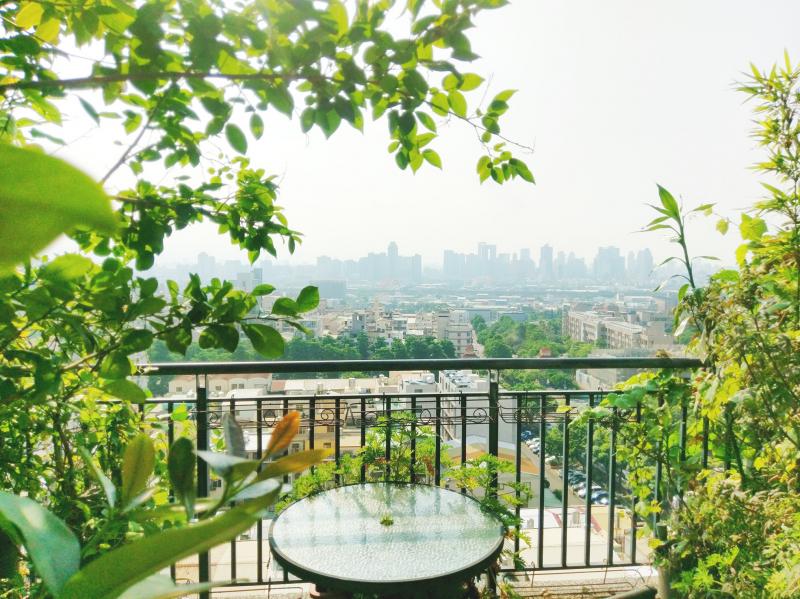
Photo courtesy of Courtney Donovan Smith
“I got a few plants and put a table and some chairs on one of the two decks,” he recalls.
Over time, Smith added an apple tree, fig trees and aromatic herbs. He grew blueberries, Brazilian cherries, lychees, strawberries and tomatoes. Cucumbers, lettuces and other vegetables from the garden “definitely improved” his diet, he says.
When city folks grow flowers, herbs or vegetables (scallions are especially popular) on their roofs and balconies, benefits go far beyond the aesthetic and culinary.
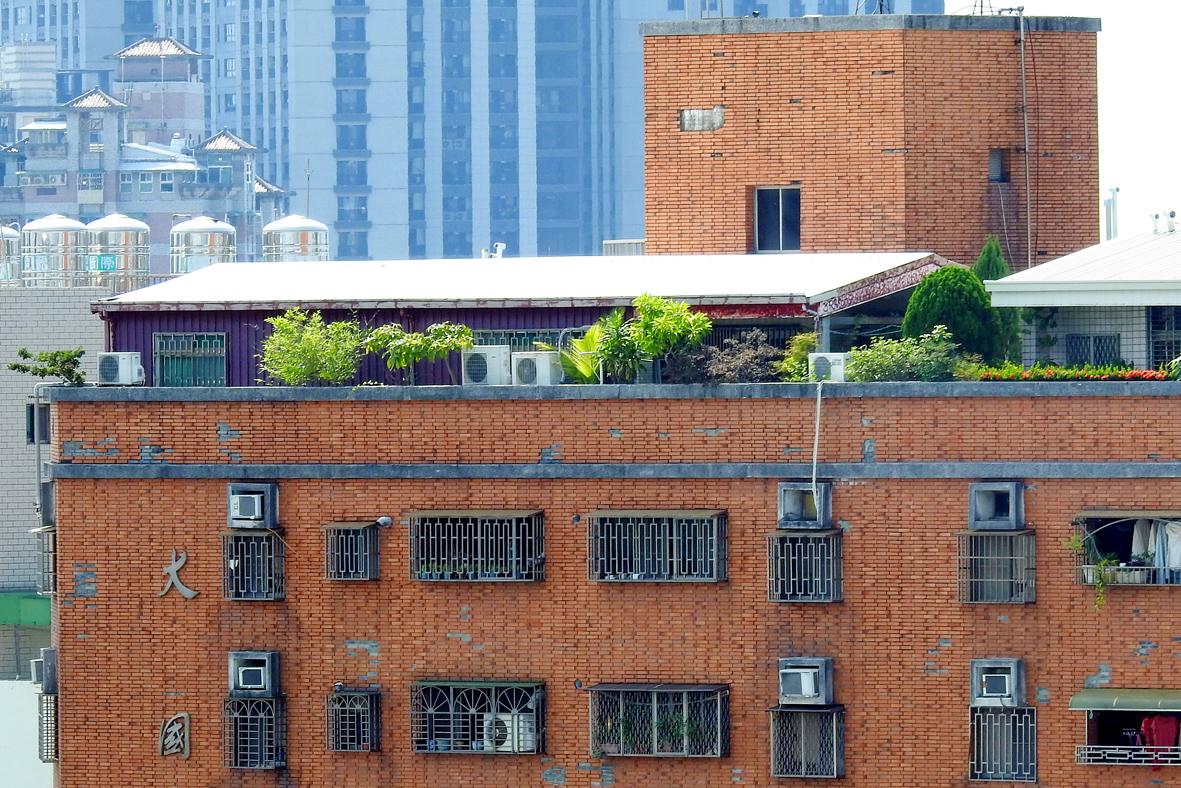
Photo: Steven Crook
Plants are a boon for insects, which in turn is a key food source for bird and bat populations.
Foliage reduces temperatures by blocking direct sunlight and through the process of evapotranspiration. Leaves trap particulate pollution and muffle the sound of traffic.
If there were more of them, rooftop gardens might even help mitigate flooding. A cubic meter of dryish soil may absorb over 10 liters of rainwater. Leaves also stop some raindrops from reaching the ground until after the shower is over.
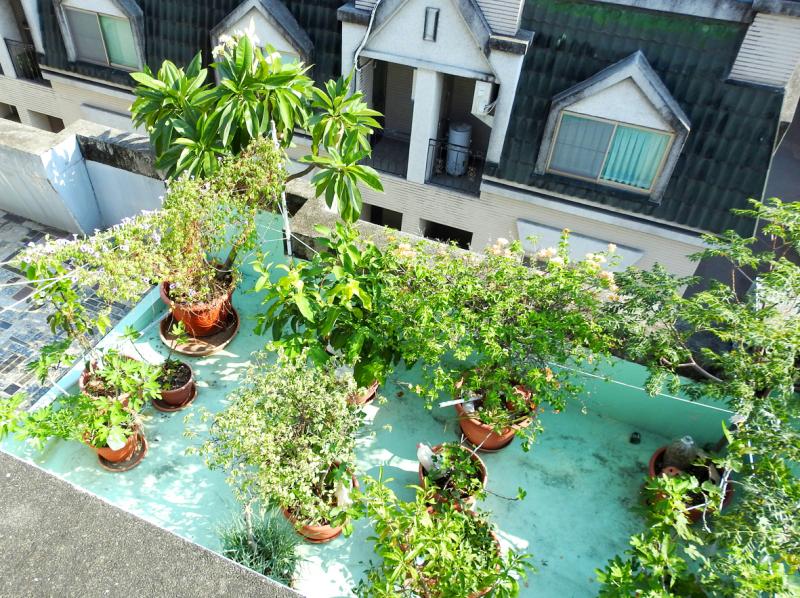
Photo: Steven Crook
‘WICKING SYSTEMS’
Smith says that looking after his garden, “got to a point where it was a real time-suck. In the summer, I spent an average of 90 minutes each day watering. That’s when I started looking into wicking systems.”
Wicking beds are containers that store water at the base. Moisture moves upward through the soil due to capillary action (“wicking”).
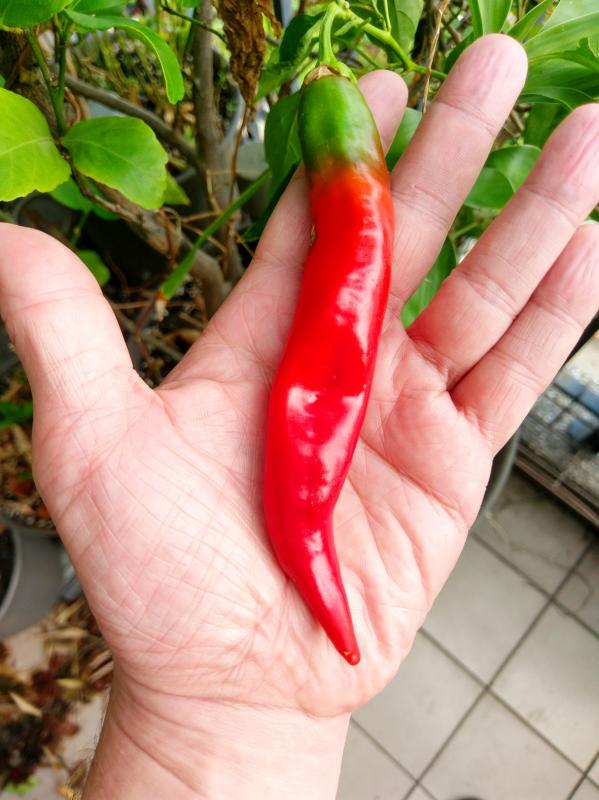
Photo courtesy of Courtney Donovan Smith
In addition to reducing the frequency with which water has to be added, wicking systems cut losses through evaporation. Furthermore, because plants always seek out moisture, those in wicking beds grow deeper roots, which makes them healthier and less vulnerable to drought and strong winds. Because the surface of the soil is relatively dry, fungal infections are less likely, and the garden is less attractive to slugs and snails.
Once he’d got his wicking system perfected, Smith says he felt that very little of the work he did on his garden was tedious. Most mornings, he’d check the plants, add water if necessary — and notice any overnight changes.
“Spending 10 or 20 minutes in the garden just before going to work really cleared my brain, and helped me focus on what I needed to get done that day,” he remembers.
On weekends, he’d often labor in the garden for an hour or two, more often for fun than because the garden needed attention.
“The garden was so big it had its own ecosystem. I stopped using pesticides, because I realized if there was an issue, a predator would come eventually along. I had a problem with grasshoppers for a while, but then praying mantises somehow got up to the tenth floor,” Smith says.
Rooftop gardening doesn’t have to be an expensive pastime. Each wicking bed cost Smith between NT$500 and NT$1,000. In all, he estimates he spent a bit over NT$100,000 on his urban paradise.
For those who can’t tend their plants every day, there’s a solution that’s cheaper, albeit less elegant, than wicking systems.
An HDPE bottle with a tiny puncture in its base, filled with water and left on the surface of the soil, reduces the need for frequent watering. But old milk jugs do nothing to beautify a roof terrace, and they eventually disintegrate because of UV light.
Some rooftop or balcony gardeners grab all the soil they need from the countryside. Smith, however, bought bags of it from a gardening center. Taking rural dirt would have meant traveling some distance out of the city, and much of the land in nearby Longjing District (龍井) is tainted by industrial pollutants, he says. What’s more, he adds, the better the soil, the better a wicking bed will work.
Smith was devastated when he had to move.
“It broke my heart to lose that place and that garden. It was a big part of my life,” he says.
He shifted some of the plants to his new apartment, and others to his office. He’s still looking for an affordable place with a sizable rooftop — and still encouraging others to try their hand at creating a garden high above street level.
Some people are reluctant to have plants on their roofs or balconies because they worry that leaves might block the drains, or the foliage will become a haven for mosquitoes.
Smith encountered neither of these problems. From time to time, however, soil cockroaches (which are different to the cockroaches usually seen indoors) got into his apartment.
ENVIRONMENTAL BENEFITS
Most of Taiwan’s rooftops are concrete or sheet metal. Under direct sunlight, these surfaces can become much hotter than the surrounding air, and they retain heat for hours afterward.
Researchers in Saudi Arabia are among those who’ve concluded that rooftop greenery can significantly cut energy consumption and electricity bills.
In a conference paper published in 2018, the team from King Abdulaziz University reported that, while after-dusk and early-morning temperatures inside a building with a rooftop garden were fractionally higher than those in an identical building without any foliage, between 10am and 4pm, the interior of the former was up to 5.2 degrees Celsius cooler than the interior of the latter.
Rooftop farms offer similar cooling and biodiversity benefits. In addition, they can shrink the distance between where lettuce is grown and where it’s eaten. Minimizing “food miles” is one way to mitigate the environmental impact of food production.
The case for rooftop greening is strong. But it isn’t, it seems, clear-cut enough to convince Taiwan’s government that it should be mandatory.
This isn’t surprising. After all, the authorities merely incentivize — when they should mandate — the installation of photovoltaic (PV) arrays on suitable roofs.
Fortunately, some local leaders are determined to make urban skylines a bit leafier.
Around 11 percent of the 700-plus gardens supported by Taipei City Government’s Garden City program are situated on top of buildings.
Since 2019, the Tainan City Government has worked with an NGO, Taiwan Green Roof & Green Wall Association (台灣綠屋頂暨立體綠化協會), to support several rooftop greening projects. As part of the approval process, experts evaluate the waterproofing and load-bearing characteristics of each roof.
The program’s budget was NT$3 million last year and the same this year. Projects that cover at least 50 square meters can apply for subsidies of up to NT$60,000 per 10 square meters. The money can be used to construct planting bases, troughs, living-plant curtains, ecological ponds and explanation boards.
Most rooftop gardens are on flat surfaces, but Tainan’s Yongfu Elementary School’s (永福國小) seven-meter-wide corridor of flowers, drought-resistant plants and turf slopes at an angle of 15 to 20 degrees.
Kaohsiung City Government’s Three-dimensional Greening Plan offers subsidies to those who transform their roofs in ways that make the city more livable, and that “increase recreational space for residents, promote pesticide-free agriculture and the establishment of ‘ecological islands,’ reduce the ‘heat island’ effect, and result in energy-saving and carbon-reducing buildings” (to quote the Web site of the city’s Public Works Bureau).
Kaohsiung Main Public Library (高雄市立圖書館總館) has foliage-rich balconies and a flat roof that includes a performance space, a garden and a modest PV array.
Asking in 2016 how we should respond to the worsening “heat island” effect in Taiwan’s big cities, Our Island (the official blog of the PTS environmental news program of the same name) implored: “Change should start on our roofs!”
Five years on, urban neighborhoods are still dominated by tiles and tiepi (鐵皮, sheet-metal roofing). If we’re not going to roast in our own homes, change needs to come a lot quicker.
Steven Crook, the author or co-author of four books about Taiwan, has been following environmental issues since he arrived in the country in 1991. He drives a hybrid and carries his own chopsticks. The views expressed here are his own.
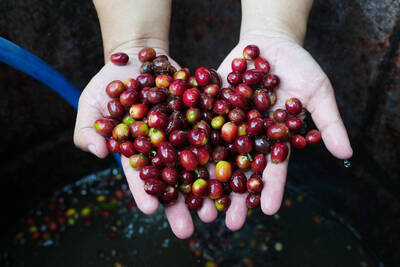
Climate change, political headwinds and diverging market dynamics around the world have pushed coffee prices to fresh records, jacking up the cost of your everyday brew or a barista’s signature macchiato. While the current hot streak may calm down in the coming months, experts and industry insiders expect volatility will remain the watchword, giving little visibility for producers — two-thirds of whom farm parcels of less than one hectare. METEORIC RISE The price of arabica beans listed in New York surged by 90 percent last year, smashing on Dec. 10 a record dating from 1977 — US$3.48 per pound. Robusta prices have
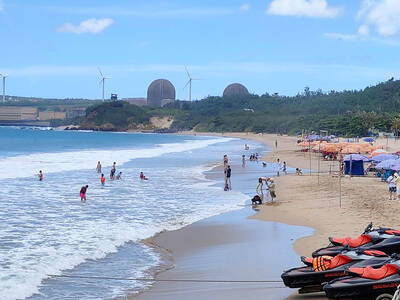
A dozen excited 10-year-olds are bouncing in their chairs. The small classroom’s walls are lined with racks of wetsuits and water equipment, and decorated with posters of turtles. But the students’ eyes are trained on their teacher, Tseng Ching-ming, describing the currents and sea conditions at nearby Banana Bay, where they’ll soon be going. “Today you have one mission: to take off your equipment and float in the water,” he says. Some of the kids grin, nervously. They don’t know it, but the students from Kenting-Eluan elementary school on Taiwan’s southernmost point, are rare among their peers and predecessors. Despite most of
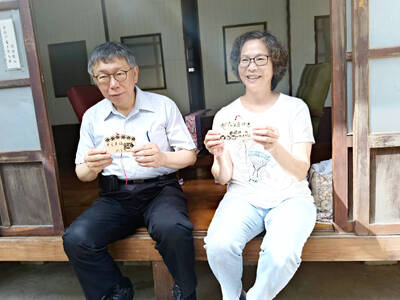
The resignation of Taiwan People’s Party (TPP) co-founder Ko Wen-je (柯文哲) as party chair on Jan. 1 has led to an interesting battle between two leading party figures, Huang Kuo-chang (黃國昌) and Tsai Pi-ru (蔡壁如). For years the party has been a one-man show, but with Ko being held incommunicado while on trial for corruption, the new chair’s leadership could be make or break for the young party. Not only are the two very different in style, their backgrounds are very different. Tsai is a co-founder of the TPP and has been with Ko from the very beginning. Huang has
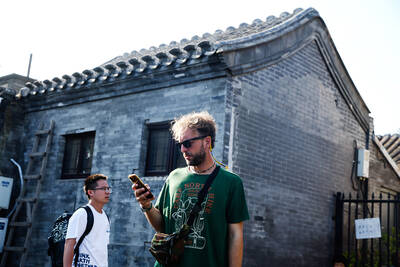
A few years ago, getting a visa to visit China was a “ball ache,” says Kate Murray. The Australian was going for a four-day trade show, but the visa required a formal invitation from the organizers and what felt like “a thousand forms.” “They wanted so many details about your life and personal life,” she tells the Guardian. “The paperwork was bonkers.” But were she to go back again now, Murray could just jump on the plane. Australians are among citizens of almost 40 countries for which China now waives visas for business, tourism or family visits for up to four weeks. It’s